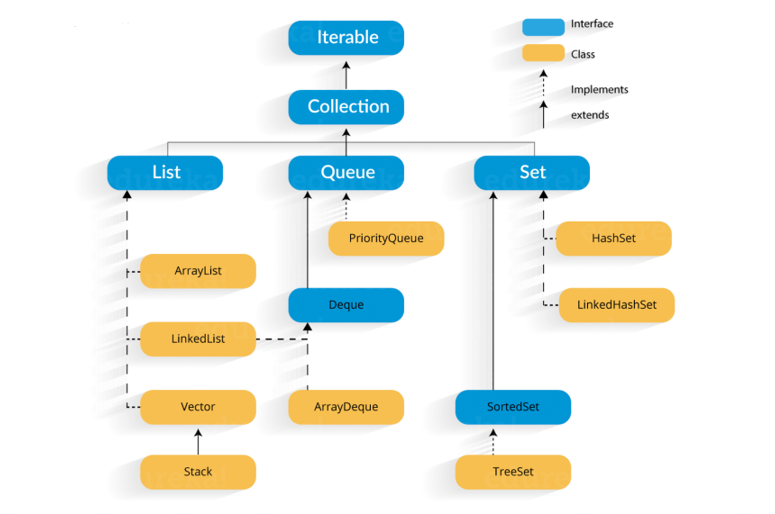Subscribe
Subscribe to EduBridge Blogs
How do Java collections work? Java collections are a group of distinct objects that are shown as a single entity. Java collections provide all actions, including searching, sorting, insertion, manipulation, deletion, etc., just like data.
Let’s continue with this blog post about Java collections and Java Collection Framework, so that we may comprehend each component in turn:
What is Java Collection Framework?
An architecture for storing and managing a collection of items is provided by a Java collection framework. An example of a Java collection framework is:
- Interfacess
- Classess
- Algorithm
Let’s discover more about them in depth:

Interfaces: Abstract data types are referred to as interfaces in Java. They make it possible to manipulate Java collections without being constrained by the specifics of their representation. In object-oriented programming languages, they also create a hierarchy.
Classes: The collection interface is implemented by classes in Java. In essence, it refers to data structures that are often utilized.
Algorithm: The term “algorithm” refers to the techniques used to carry out actions on objects that implement collection interfaces, such as searching and sorting. Algorithms are polymorphic by nature since a single algorithm can be used to perform many implementations of the Java collection interface.
So why do you think Java collections are necessary?
The Java collection framework gives programmers access to predefined data structures and data manipulation methods. Let’s next examine the hierarchy of the Java collections framework to determine where these interfaces and classes are located.
Java collection: Why use it?
Using Java collections has a number of advantages, such as:
- Reducing the time spent writing code by offering practical data structures and algorithms
- Java collections offer fast and effective data structures and algorithms, boosting the efficiency and effectiveness.
- Collection interfaces can be sent back and forth by unrelated APIs.
- Reduces the additional effort needed to understand, use, and create new APIs
- Encourages the reuse of common data structures and algorithms
Hierarchy of the Java Collection Framework
As we have taught, classes and interfaces are part of the Java collection framework. Let’s now examine the hierarchy of the Java collections framework.

The blue portion of the figure above relates to the various interfaces, and the yellow portion denotes the class. Let’s now examine these elements in further depth.
Java Collections: Interface
The elements are iterated over an interface called an iterator. It’s employed to iterate through the list and change the elements. The three methods of the iterator interface are as follows:
public boolean next() – This method returns true if the iterator has more elements.
public object next() – It returns the element and moves the cursor pointer to the next element.
public void remove() – This method removes the last elements returned by the iterator.
List, Queue, and Sets are the three components that expand the collection interface. Let’s discover more about them in depth:
List of Java collections
A list is a collection of elements that have been arranged and may include duplicates. It is a supplementary interface to the Collection interface. Lists can also be divided into the following categories:
- ArrayList
- LinkedList
- Vectors
Let’s examine each of these in more detail:
ArrayList is a List Interface implementation that allows for the dynamic addition and removal of entries from the list. Additionally, if more entries are added to the list than the initial number, the list’s size is dynamically raised.
Single Linked List is a list that maintains the data for each node in the list with a pointer or reference to the node after it in the list.
A doubly linked list has two references, one to the node after it and the other to the node before it.
Vector is the element of an object that can be retrieved using an index into the vector, which is similar to how arrays work. A dynamic array is implemented via vector. Additionally, the vector is not constrained to a certain size; if needed, it can dynamically increase or shrink. It and ArrayList are comparable, but there are two differences:
- The vector is coordinated.
- There are numerous historical methods in Vector that are not included in the collections framework.
Let’s move on to the next Java Collections interface subtype, queue.
Java collections: The FIFO method, or ordering the elements First In First Out, is used by the queue queue. The first element in a queue is eliminated first, while the last piece is eliminated last. Each fundamental method has two variations: one returns a unique value in the event of an error, the other throws an exception.
Priority queue also uses the Queue interface. The components of the priority queue are arranged either by a Comparator provided at the time of queue building, or in accordance with their natural ordering. According to the given ordering, the item at the front of this queue is the least important one.
Java Collections Sets: A collection that excludes duplication is referred to as a set. It is mostly used to model the abstraction of the mathematical set. There are many classes that implement Set, including HashSet, TreeSet, and LinkedHashSet.
HashSet: A collection using a hash table as storage is created via the Java HashSet class. Hashset inherits the AbstractSet class, implements the Set interface, and only contains distinct elements. Additionally, it stores the elements using a hashing technique.
Linked Hashset: The Java LinkedHashSet class implements the set interface using a hash table and linked list. It only includes distinct components, such as HashSet. In addition, Linked HashSet offers all available set operations and preserves insertion order.
TreeSet: The class TreeSet implements the Set interface, which stores data in a tree. This class’s objects are kept in ascending order in storage. Additionally, it implements the NavigableSet interface and inherits the AbstractSet class. It only includes distinct components, such as HashSet. Access and retrieval times are quicker in the TreeSet class.
In this blog post, we briefly discussed what a collection framework in Java is and how it works. We also learned that the Java collections provide all actions just like data. The most important thing to remember when working with collections is to be careful not to insert duplicate objects into the same collection.
Recent Blogs
Related Blogs
Accelerate Your Career with Expert Guidance and Guaranteed Job*!
"*" indicates required fields




